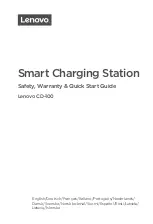
A3
Locate Charger
•
Locate the charger as far away from battery as the DC cord permits.
•
While charging do not place charger directly above or below the battery. Gases or fluids from the battery may corrode
and damage the charger.
•
Never allow battery acid to drip on the charger.
•
Charging should be carried out in a well-ventilated, weather protected facility.
Battery Type & Settings
The following recommendations should only be referred to as guidelines. For precise details, you must refer to battery
manufacturer for instructions.
Symbol Mode Settings Details
This mode is normally suitable for 24V WET,
MF and GEL batteries.
This mode is recommended for several 24V
AGM batteries. It is also suitable for charging
batteries in sub-zero temperatures.
This mode is normally suitable for 12V WET,
MF and GEL batteries.
This mode is recommended for several 12V
AGM batteries. It is also suitable for charging
batteries in sub-zero temperatures.
a) Maintenance of 12V Lead-Acid rechargeable batteries:
This mode is suitable for maintenance of
12V batteries with capacity range from
14-230Ah. The charger delivers a constant
voltage of 13.6V. This is maintenance mode
for applications where maximum capacity
from the battery is required such as Golf
Carts, Floor Sweepers etc.
b) Power source:
INVATEC
SC-7 battery
charger is also used as a power supply,
without attaching a battery in this mode.
The charger delivers 13.6V/5A. Spark free
function is inactivated. However reverse
polarity protection function still works.
BOOST
This mode is mainly applied for recovering 12V
batteries with capacity range from 14-230Ah in
normal condition. To recover severely discharged
batteries due to stratified acid, this mode is useful.
High voltage (17V max) at 1.5A is applied for a
maximum period of 3 hours. A fully charged battery
gives faster result. High voltage may cause some
water loss. For optimal efficiency and minimum risk to
vehicle’s / boat’s electronics, battery must be
disconnected.
•
Do not cover the charger while charging.
•
Do not touch the battery clips together when charger is connected with mains.
•
After charging, disconnect the battery charger from supply mains. Remove the chassis connection and the battery connection, respectively. This
will reduce back drain current.
•
Charging must be ceased immediately if battery is found to be too hot or leaks out liquid during charging.
•
In case of malfunction or damage, immediately disconnect the charger from the mains.
•
Do not use vehicle when charging permanently installed batteries.
•
During charging the battery must be placed in a well ventilated area.
•
Danger of chemical burns!
Battery acid is highly corrosive. If your skin or eyes come into contact with acid, immediately rinse the affected part of
the body with excessive water and seek medical advice.
•
This appliance is not intended for use by persons (including children) with reduced physical, sensory or mental capabilities, or lack of experience
and knowledge, unless they have been given supervision or instruction concerning use of the appliance by a person responsible for their safety.
•
Children should be supervised to ensure that they do not play with the appliance.
•
Ensure that charger switches to maintenance charge mode, before it is left unattended and connected for long time. If this stage does not arrive
within 73 hours (max), the charger must be disconnected manually.






























